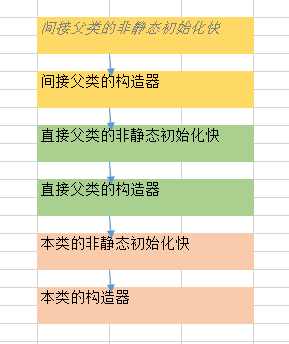new 一个子类的时候的访问顺序:

class Creature {
{
System .out. println("creature 的非静态初始化 ");
}
public Creature () {
super();
System .out. println("creature 的构造方法 ");
}
}
class Animal extends Creature {
{
System .out. println("animal 的非静态初始化 ");
}
public Animal () {
super();
System .out. println("animal 的构造方法 ");
}
}
public class Monkey extends Animal {
{
System .out. println("monkey 的非静态初始化 ");
}
public Monkey () {
super();
System .out. println("monkey 的构造方法 ");
}
public static void main (String[] args) {
new Monkey();
}
}
输出结果:

非静态初始化块的执行总是先于构造器执行的
super(Para p1,Para p2......); 根据参数调用父类对应的构造方法
this(Para p1,Para p2......); 根据参数调用本类对应的构造方法
对于一个无参的构造器,会有一个默认的super(),她会调用父类的无参的构造方法